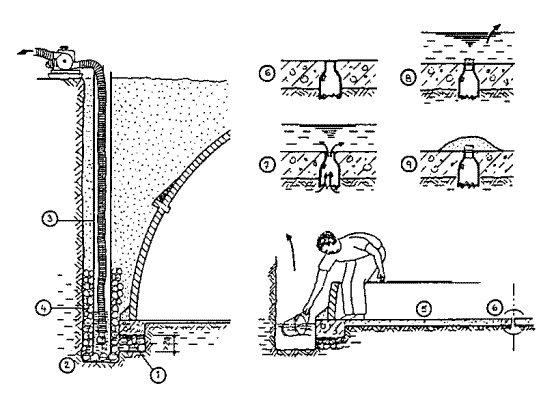Knowledge fuels change
For over a decade, Energypedia has shared free, reliable energy expertise with the world.
We’re now facing a serious funding gap.
Help keep this platform alive — your donation, big or small, truly matters!
Thank you for your support
Difference between revisions of "Biogas Implementation - Groundwater Management"
***** (***** | *****) m |
***** (***** | *****) m |
||
| Line 24: | Line 24: | ||
<br> | <br> | ||
| − | [[Construction of a Biogas Plant|Back to "construction"]] | + | [[Construction of a Biogas Plant|Back to "construction"]] |
| − | <br> | + | <br> |
[[Category:Biogas]] | [[Category:Biogas]] | ||
Revision as of 15:38, 23 March 2009
Underground water features in all three steps of biogas implementation:
- During planning, the site selection and design of the digester can eliminate most of the problems caused by groundwater and threats to groundwater.
- During construction, groundwater can be a nuisance, effecting additional costs. But it is during construction, that serious leakage can be avoided.
- During operation, little can be done but to monitor the quality of water and to avoid surface spilling.
By positioning the biogas plant and the well, a great deal of drinking water safety can be achieved. First, the distance should be at least 30 m, second, the biogas plant should be downstream of surface- and groundwater flows and third, the well should be above the biogas unit to avoid contamination through surface spilling.
During construction, ground water must be drained. An empty biogas digester can develop such buoyancy, if surrounded by water, that the whole shell is lifted. The figure below illustrates some simple techniques how to deal with ground water during construction of small biogas plants.
During the operation of the biogas plant further attention has to be paid to keeping the groundwater clean. Seeping biogas digesters and unprotected slurry storage can pollute water sources chemically (nitrate poisoning can be fatal for infants) and biologically (mainly with toilet biogas plants). Reasons may be wrong configuration of security devices like the pressure relief valves or because of leakage in lower parts of the digester. Smaller cracks, however, close up in the course of time through particles in the slurry.
Trace metals applied to natural systems do not pose a threat to groundwater quality because trace metals are usually removed from the percolating water by adsorption or chemical precipitation within the first few meters of soil, even in rapid infiltration systems with high hydraulic-loading rates.
Bacterial removal from effluents passing through fine soils is quite complete. It may be less complete in the coarse, sandy soil used for rapid infiltration systems. Fractured rock or limestone cavities may provide a passage for bacteria that can travel several hundred meters from the point of application. This danger can be avoided by proper geological investigations during site selection.
Back to "construction"




















